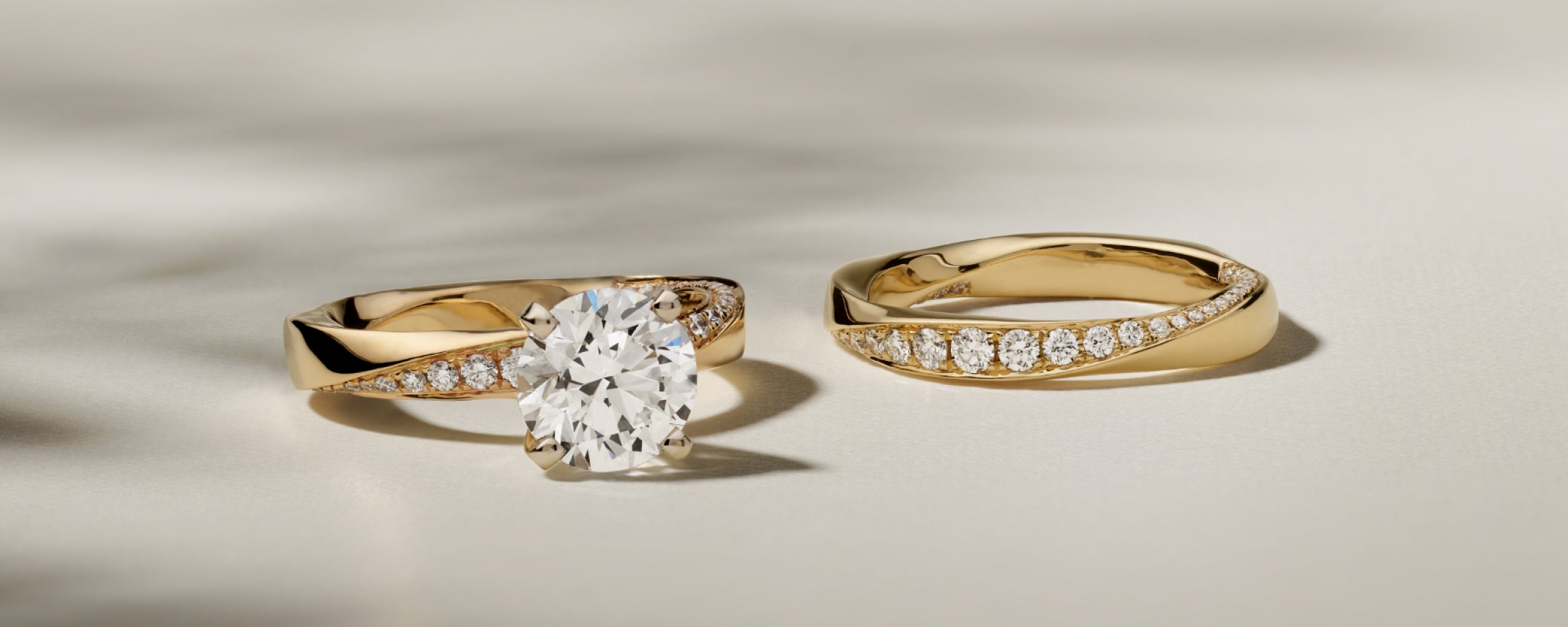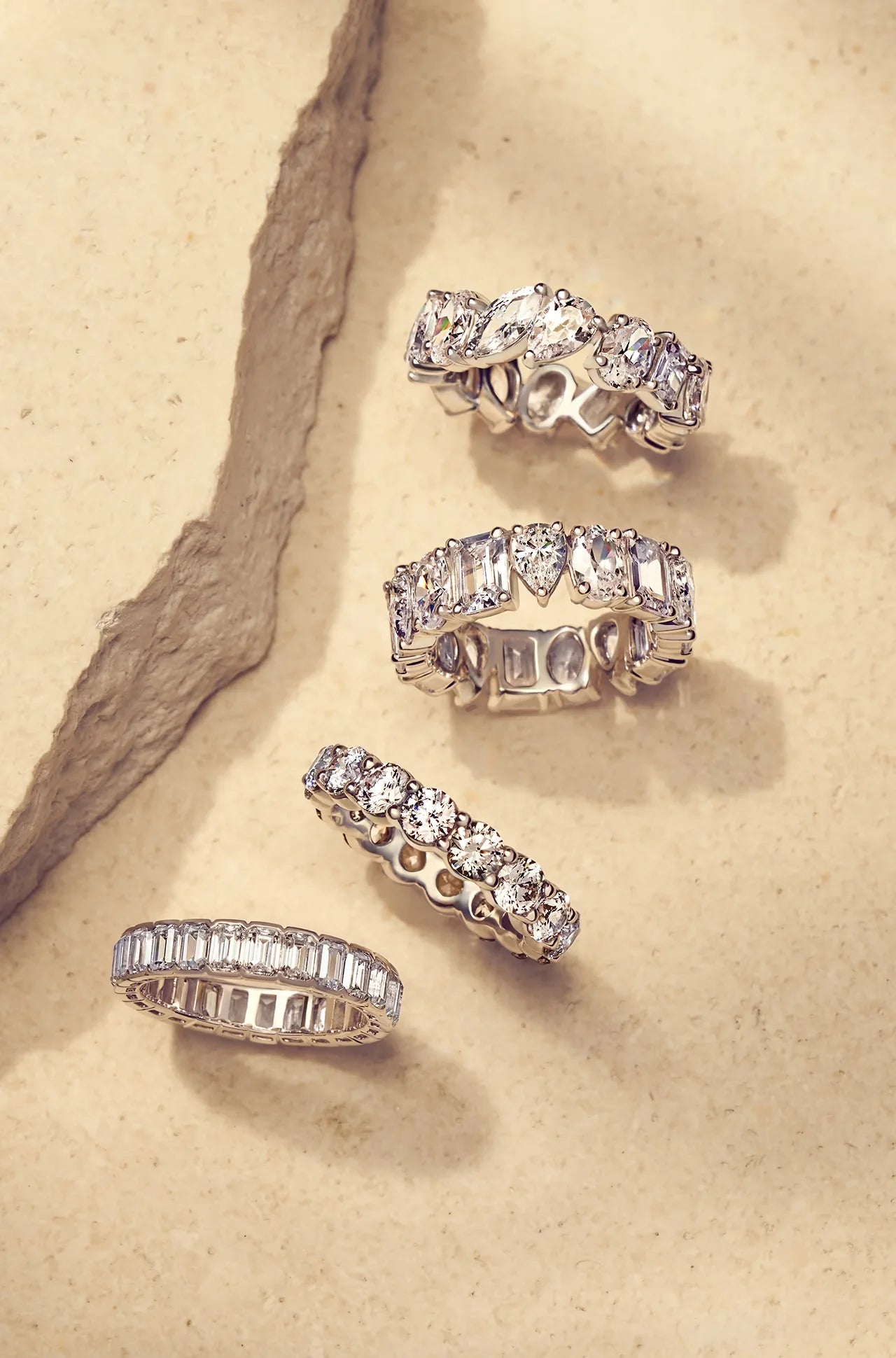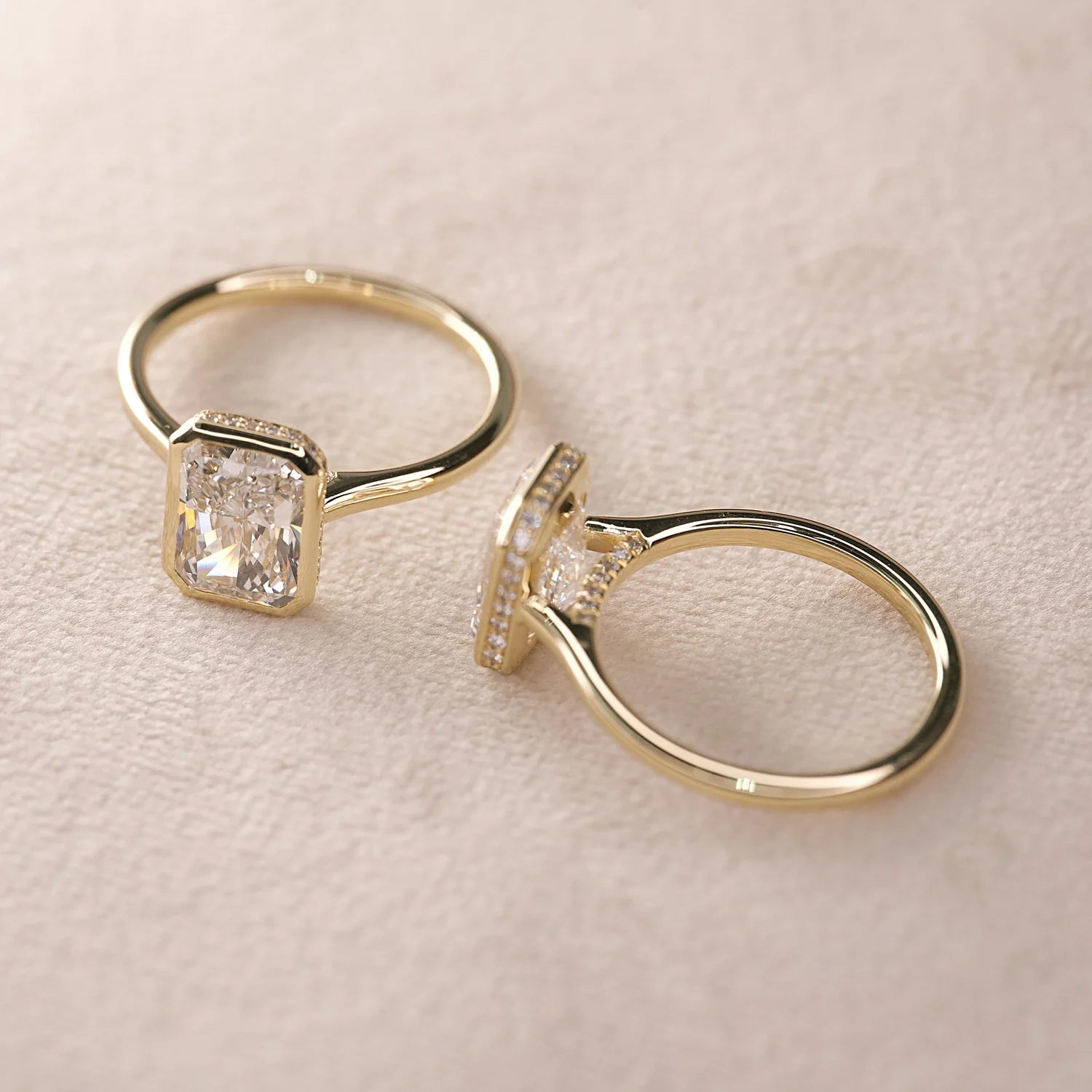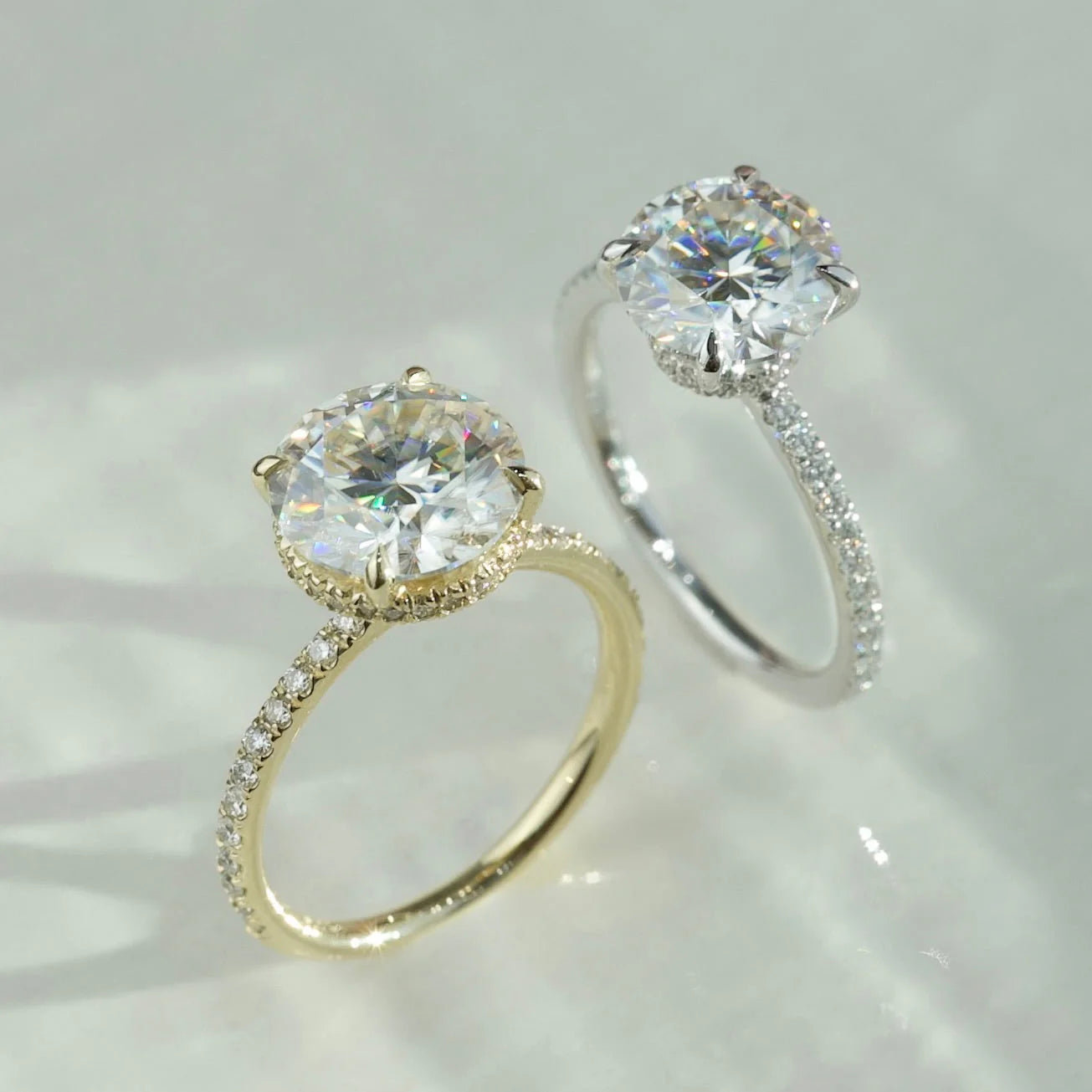
Moissanite Guide
We have created this guide for you to take a closer look at moissanite and to help you decide between diamonds and moissanite.
What is Moissanite?

Moissanite is a mineral composed of silicon carbide. Often referred to as the gemstone from the stars, it was discovered in 1893 inside of a meteorite in Canyon Diablo, Arizona, by Nobel Prize-winning chemist Henri Moissan. Initially mistakenly identifying his discovery as diamonds, it wasn’t until 1904 that Moissan determined the crystals were, in fact, silicon carbide. This naturally occurring mineral form of what we now call moissanite was named in honor of Moissan later in his life.
In its natural form, moissanite remains very rare. It wasn’t until 1958 that geologists found it outside of meteorites: first, in the Earth’s upper mantle near Wyoming, and then, the following year, as inclusions in rock in Russia.
Today, moissanite is exclusively grown in laboratories as an alternative to diamonds. Created in a controlled environment with advanced technology, it is easily traceable and requires no mining. This means moissanite has a smaller carbon footprint and lessened environmental impact than a naturally mined gem.
Increasingly popular as an alternative to diamonds, moissanite is now widely used in jewelry, especially as the center stone of engagement rings.
Why do Moissanite Differentiate?
-

Value For Money
Moissanites are priced at 1/10th the cost of Natural Diamonds
-

Durability
With a ranking of 9.25 on the Moh's Scale of Hardness Moissanites are extremely durable
-

Conflict Free
Moissanites are created without any disruption caused to the environment
Is a Moissanite a Diamond?

No, a moissanite is not a diamond. Professionals grow them in laboratories because they are visually similar to diamonds, but compositionally they’re quite different. Diamonds are composed of carbon and moissanites are composed of silicon carbide.
While the untrained eye may visually perceive a moissanite as similar to a diamond, it has a higher refractive index — meaning it produces more rainbow ‘fire’ than a diamond when light hits the stone’s surface. Diamond is also physically harder than moissanite, which is a 9.25 on the Mohs hardness scale compared to a diamond’s rating of 10.
While they both feature dispersion, scintillation, and are both considered to be good thermal conductors, moissanites and diamonds are otherwise distinct.
How are Moissanite Made?
-
Step 1
Charles & Colvard (C&C) receives single silicon carbide crystals (precision cut into small pieces called preforms) from Cree.
-
Step 2
Preforms sent overseas to high-volume faceting (like a record player) vendors who hand-cut & polish the preforms to C&C Standards.
-
Step 3
Lower portion of the gemstone (pavilion) is formed by grinding the pavilion.
-
Step 4
Next the girdle (the edge of the stone that is grasped by the setting) followed by the pavilion facets, are cut & polished.
-
Step 5
Gemstone is removed from the machine & reattached with the top of the stone (crown) for cutting.
-
Step 6
Lastly, the table (upper flat surface) is polished & the stone is ready to be sent to C&C for distribution.
Moissanite vs. Diamond
-
Moissanite
Composition: Composed of silicon carbide, moissanite is a naturally occurring mineral found in limited quantities on Earth, but most moissanite used in jewelry is lab-created.
Hardness: Second only to diamonds in hardness on the Mohs scale, moissanite scores 9.25, making it highly durable and resistant to scratching or chipping.
Brilliance and Sparkle: Moissanite: Known for its exceptional brilliance and fire, moissanite exhibits a dazzling sparkle due to its high refractive index, dispersing light into colorful flashes.
Color: Moissanite: Generally, moissanite exhibits minimal to no color and is graded on a color scale from D to K, with D being colorless and K showing slight yellow or gray undertones.
Cost: Moissanite: Moissanite is typically more affordable than diamonds of comparable size and quality, offering an excellent alternative for those seeking brilliance without the high cost.
Origin and Sustainability:Moissanite: Most moissanite available today is lab-created, offering an eco-friendly and sustainable alternative to mined gemstones.
Popularity and Tradition: Moissanite: Growing in popularity as an alternative gemstone for engagement rings and fine jewelry, moissanite offers a modern yet timeless choice for those seeking brilliance and affordability.
-
Diamonds
Composition: Comprised of carbon atoms arranged in a crystalline structure, diamonds are formed deep within the Earth's mantle over millions of years.
Hardness: Diamonds are the hardest natural substance, scoring a perfect 10 on the Mohs scale, making them extremely durable and ideal for everyday wear.
Brilliance & Sparkle: Renowned for its unmatched brilliance, diamonds disperse light beautifully, resulting in a captivating sparkle with a play of light known as "diamond fire."
Color: Diamonds come in a range of colors, from colorless (D) to light yellow or brown, with color grades affecting their value and rarity.
Cost: Diamonds are traditionally more expensive due to their rarity and demand, with factors such as cut, color, clarity, and carat weight influencing their price significantly.
Origin & Sustainability: Mined diamonds have raised concerns regarding environmental impact, labor practices, and ethical sourcing, although efforts are being made to promote responsible mining practices and traceability.
Popularity and Tradition:Diamonds have long been synonymous with luxury, romance, and tradition, making them a popular choice for engagement rings and special occasions for centuries.

Tips on Selecting a Moissanite
While shopping for a moissanite is not unlike shopping for any other gemstone, there are a few things to keep in mind.
Unlike diamonds that are graded by independent institutions on cut, color, clarity, and carat, moissanites are reviewed only for cut, color, and clarity. Then, at Brilliant Earth, they’re categorized by their color and rated as Premium or Super Premium. A Premium moissanite is similar to a G-H color diamond, while a Super Premium moissanite is in the D-E-F range. As the technology to create a moissanite is so advanced, there is very little variation in their quality.
Lastly, it’s most important to consider if moissanite is the right gemstone for you. To come to a conclusion, think about its difference from diamonds (its fire, scintillation, price, and durability) to determine if it’s your ideal fit.



